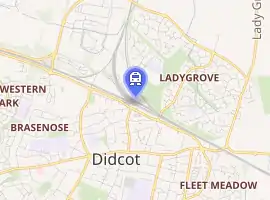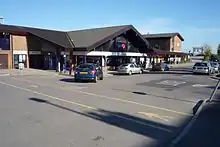Didcot Parkway railway station
Didcot Parkway is a railway station serving the town of Didcot in Oxfordshire, England. The station was opened as Didcot on 12 June 1844[1] and renamed Didcot Parkway on 29 July 1985 by British Rail[1] to reflect its role as a park and ride railhead. It is 53 miles 10 chains (85.5 km) down the line from London Paddington and is situated between Cholsey to the east and Swindon to the west.[2]
 The front of Didcot Parkway Railway Station in November 2020. | |
| Location | Didcot, District of South Oxfordshire England |
| Coordinates | 51.61197°N 1.24348°W |
| Grid reference | SU525905 |
| Managed by | Great Western Railway |
| Platforms | 5 |
| Other information | |
| Station code | DID |
| Classification | DfT category B |
| History | |
| Original company | Great Western Railway |
| Pre-grouping | Great Western Railway |
| Post-grouping | Great Western Railway |
| Key dates | |
| 1844 | Opened |
| 1962 | Line to Newbury closes to passengers |
| 1985 | Renamed Didcot Parkway |
| Passengers | |
| 2015/16 | |
| Interchange | |
| 2016/17 | |
| Interchange | |
| 2017/18 | |
| Interchange | |
| 2018/19 | |
| Interchange | |
| 2019/20 | |
| Interchange | |
| Location | |

| |
| Notes | |
Passenger statistics from the Office of Rail and Road | |
The station is served by local services operated by Great Western Railway from Reading to Didcot and Oxford, and by main line services from Paddington to the south-west of England and south Wales.
Just to the north of the station is the Didcot Railway Centre, which is accessed through the station. The centre is a comprehensive exhibition of original Great Western Railway rolling stock, with demonstration running tracks and including a reconstructed station named Didcot Halt.
History
The railway has run through Didcot since 1 June 1840, when the Great Western Railway extended its main line from Reading to Steventon. During this period a stagecoach transported passengers to Oxford from Steventon. A few weeks later the line was extended to Faringdon Road station near West Challow, and eventually to Bristol. On 12 June 1844 the line from Didcot to Oxford was opened and Didcot station was opened at the junction. The original intended route would have taken a line from Steventon to Oxford via Abingdon, but Abingdon's townspeople objected to this idea.[3] Otherwise, it is unlikely that Didcot would have evolved into the town it is today, as its initial growth was prompted by the coming of the railway.
The Didcot, Newbury and Southampton Railway (DN&S) linked Didcot with Newbury, carrying services to Southampton via Newbury, Highclere, Winchester and Eastleigh. In its latter years it was reduced to a rural backwater before its closure just before the Beeching cuts. The DN&S was closed to passengers on 10 September 1962 and to freight in 1967. At the eastern end of Platform 1, there is a raised section of the east car park, which used to be the bay platform for the DN&S line.
On 7 December 1964, local passenger services between Didcot and Swindon were withdrawn and the stations at Steventon, Wantage Road, Challow, Uffington, Shrivenham and Stratton Park were closed.[4][5]
In 1985, a new main building for the station was built along with a new 600-space car park on the site of the former provender store to the west of the station for Park and Ride use. These were opened on 29 July 1985 by David Mitchell MP, Parliamentary Under Secretary of State for Transport, and on that date the station was renamed Didcot Parkway.[6]
In 2018, a multi-storey car park was opened, costing £20 million and increasing the number of spaces by 65% to 1800. The car park also has a sheltered footbridge.[7]
Layout
Platforms

The station is located just to the north of the town centre in Didcot. It can only be accessed by car from Station Road itself on the south side of the railway, although passengers may park in Foxhall Road Long Stay Car Park, situated on Basil Hill Road, and cross a footbridge to the station. The station entrance is at road level; platforms 2-5 may be accessed by lifts, while platform 1 may be accessed from the ramp to the left of the station building near the taxi rank. All services are operated by Great Western Railway.
- Platform 1 – Down (westbound) express services to Bristol Temple Meads, Cheltenham Spa, Cardiff Central and Swansea, limited services to Weston-super-Mare, Exeter St Davids and Carmarthen.
- Platform 2 – Up (eastbound) express services to London Paddington.
- Platform 3 – Down (northbound) local services to Oxford, Hereford and Banbury.
- Platform 4 – Up local services to Reading and London Paddington,
- Platform 5 – Down (northbound) local services to Oxford and Banbury.
Junctions and yards
| Railways around Didcot | |||||||||||||||||||||||||||||||||||||||||||||||||||||||||||||||||||||||||||||||||||||||||||||||||||||||
|---|---|---|---|---|---|---|---|---|---|---|---|---|---|---|---|---|---|---|---|---|---|---|---|---|---|---|---|---|---|---|---|---|---|---|---|---|---|---|---|---|---|---|---|---|---|---|---|---|---|---|---|---|---|---|---|---|---|---|---|---|---|---|---|---|---|---|---|---|---|---|---|---|---|---|---|---|---|---|---|---|---|---|---|---|---|---|---|---|---|---|---|---|---|---|---|---|---|---|---|---|---|---|---|
| |||||||||||||||||||||||||||||||||||||||||||||||||||||||||||||||||||||||||||||||||||||||||||||||||||||||
Didcot is a junction between the Great Western Main Line (GWML) and the route to Oxford and the Midlands. A marshalling yard is opposite platform 5[8] and another was once provided at Moreton, a little to the east. Moreton is still a junction, allowing trains to pass between the main lines on the south, and the relief and Oxford lines on the north. An avoiding line runs from Didcot East Junction, behind the marshalling yard and the Didcot Railway Centre, allowing trains to Oxford to run through without blocking the station platforms.[9] There also used to be another line at the East Junction which led to Newbury on the former DN&S railway. The track was lifted in 1967.[10]

The junction at the west end of the station which is accessible from platforms 3, 4, and 5 (the Oxford bound platforms) is known as Chester Line Junction. This is so called because that was as far at the Great Western Railway could take you from here.[11]
West of the station is Foxhall Junction which allows freight trains from Oxford to travel towards Swindon. Immediately beyond this two goods lines diverge on the north side of the line. The first served a loop for Merry-go-round trains that used to deliver coal[12] to Didcot Power Station. The second serves the Milton Freight Terminal, though this line is not in regular use.[13] Beyond this the four main and relief lines merge into three at Foxhall Junction and after a small loop just before Steventon, the four lines pass under the A34 and become two lines as far as the old station at Wantage Road.[13]
Improvement programme 2012
An improvement programme for the forecourt of the station began in September 2012 and ran for two years.[14] Key features include:
- Larger taxi rank with covered waiting area
- Dedicated drop-off and pick-up area
- Short-stay waiting bays
- Disabled parking with step-free access
- Secure cycle parking and motorcycle parking
- Pedestrian piazza with seating and a glazed atrium and walkways
- Extra bus stops with electronic real-time information
- An improved East Car Park
- Better security with CCTV and new lighting
- New drainage to alleviate flooding
- Completion of a cycle route serving the station
Electrification
As part of the 21st-century modernisation of the Great Western Main Line, the GWML was electrified to just west of Didcot Parkway in January 2018.[15] It was extended west to Swindon in November 2018. It was originally proposed that the Oxford line also be electrified, however cost blowouts resulted in this being deferred.[16] As a result, Didcot Parkway has seen an increase in the number of terminating services with Class 387s electric multiple units connecting at Didcot with British Rail Class 165 / 166 diesel multiple units.
Services
Didcot is a major junction, where the (Great Western Railway-built) line to Oxford, Birmingham New Street and further north leaves the GWML to Bristol Temple Meads via Swindon, Chippenham and Bath Spa also to Swansea via Bristol Parkway and Cardiff Central. There is no local service west of Didcot, so local service is exclusively provided by local trains taking the line to Oxford. However, a proportion of the main line services to Bristol and South Wales do stop here, with the remainder passing through the station non-stop. Fast trains to and from the Oxford line can avoid the station using the Didcot East curve.
A few trains, generally early morning weekday and Sunday services, call at Didcot for the Cotswold Line to Hereford. Infrequently trains to Weston-super-Mare and further south-west call at this station.
Didcot Parkway was served by some CrossCountry services until 2003 when Virgin CrossCountry ceased to call at the station, with all services using the Didcot East curve to and from the Oxford line. As at December 2018, one late night CrossCountry service from Reading to Birmingham New Street passes through Didcot Parkway to allow drivers to retain route knowledge. Passenger services on the West Curve ceased after Thames Trains Oxford to Bristol Temple Meads service was withdrawn in 2003.
Didcot Parkway was planned to be on East West Rail, connecting the GWML, Chiltern Main Line, West Coast Main Line, Midland Main Line and Greater Anglia together. It was planned that people will change here for connections to/from Bristol Temple Meads and South Wales.[17] As of 2020, services are not planned to extend beyond Oxford.[18]
| Preceding station | Following station | |||
|---|---|---|---|---|
| Swindon | Great Western Railway Great Western Main Line |
Reading | ||
| Terminus | Cholsey | |||
| Appleford or Radley or Oxford | Great Western Railway Cherwell Valley Line |
Terminus | ||
| Cholsey or Reading | ||||
| Historical railways | ||||
| Steventon Line open, station closed |
Great Western Railway Great Western Main Line |
Moulsford Line open, station closed | ||
| Appleford (original station) Line open, station closed |
Great Western Railway Oxford Rly |
|||
| Disused railways | ||||
| Terminus | Great Western Railway Didcot, Newbury and Southampton Railway |
Upton and Blewbury Line and station closed | ||
Accidents and incidents
- On 13 February 1861, a passenger train ran into the rear of a freight train at Didcot Junction. The guard of the freight train had failed to adequately protect the rear of his train.[19]
- On 26 September 1873, a freight train was derailed whilst being shunted to allow a passenger train to pass.[20]
- On 6 January 1932 a milk train and a freight train collided at Didcot East. The locomotive of the milk train was derailed and six tankers were slightly damaged. Ten wagons of the freight were wrecked and seventeen more were damaged. The milk train had overrun a danger signal.[21]
- On 14 August 1964 LMS Stanier Class 8F locomotive 48734 collided with a train of tank wagons at Didcot North Junction. Eleven of them were derailed and caught fire. The locomotive was severely damaged by the fire and was consequently scrapped.[22]
- On 1 January 1966 a freight train was derailed.[23]
- On 3 February 2007 a passenger train caught fire. All 400 passengers were evacuated.[24]
See also
Notes
- Butt 1995, p. 78.
- Yonge, John; Padgett, David (August 2010) [1989]. Bridge, Mike (ed.). Railway Track Diagrams 3: Western (5th ed.). Bradford on Avon: Trackmaps. map 3C. ISBN 978-0-9549866-6-7.
- Page, WH; Ditchfield, PH, eds. (1927). "The borough of Abingdon". A History of the County of Berkshire. Victoria County History. 4. London: The St Katherine Press. pp. 430–451.
- "Wantage Road station and Oxfordshire's lost railway". BBC. 28 July 2010. Retrieved 22 November 2015.
- Wilkinson, Ben (6 June 2012). "Wantage could get new station". Oxford Mail. Newsquest. Retrieved 22 November 2015.
- Slater, John, ed. (October 1985). "Didcot adds Parkway". The Railway Magazine. Vol. 131 no. 1014. Sutton: Transport Press. p. 481. ISSN 0033-8923.
- "Didcot's new multi-storey car park 'almost complete'". Oxford Mail. Retrieved 6 January 2019.
- Shannon, Paul (November 2010). "Wagonload - The End?". Railways Illustrated (93): 59. Retrieved 23 November 2015.
- Bridge, Mike (2010). Railway Track Diagrams. Bradford-On-Avon: Trackmaps. p. 3C. ISBN 978-0-9549866-6-7. Retrieved 23 November 2015.
- "Didcot, Newbury and Southampton Railway". Grace's Guide to British Industrial History. Grace's. Retrieved 23 November 2015.
- LeVay, Benedict (2014). Britain From the Rails. Bradt. p. 112. ISBN 978-1-84162-919-3.
- "Didcot A Power Station switched off after 43 years". BBC. 22 March 2013. Retrieved 23 November 2015.
- Bridge, Mike (2010). Railway Track Diagrams - Western. Bradford-On-Avon: Trackmaps. p. 4A. ISBN 978-0-9549866-6-7. Retrieved 23 November 2015.
- "Didcot Station - Latest Developments - South Oxfordshire District Council". Southoxon.gov.uk. Retrieved 7 July 2013.
- UK railway round-up
- Great Western electrification projects deferred
- "Mainline Connections - East West Rail". East West Rail. Retrieved 16 February 2018.
- "FAQ - East West Rail". East West Rail. Retrieved 16 February 2018.
- Tyler, H. W. (15 March 1861). "Great Western Railway" (PDF). Board of Trade.
- "Friday's Railway Accidents". The Times (27806). London. 27 September 1873. col B, p. 8.
- Anderson, EP (26 February 1932). "Great Western Railway" (PDF). Board of Trade.
- Kelly, Pat (15 July 2016). "While Didcot slept". Steam Railway. No. 456. Peterborough: Bauer Consumer Media Ltd. pp. 50–52. ISSN 0143-7232.
- "Derailment inquiry demand by M.P.s". The Times (56535). London. 21 January 1966. col D, p. 6.
- "Fire crews battle blaze on train". BBC News Online. 3 February 2007. Retrieved 21 July 2016.
References
- Butt, RVJ (1995). The Directory of Railway Stations. Yeovil: Patrick Stephens Ltd. ISBN 1-85260-508-1. R508.
External links
- Didcot Parkway information page on National Rail website
- Train times and station information for Didcot parkeay station from National Rail
| Wikimedia Commons has media related to Didcot Parkway railway station. |